Must-see — and little-known — art highlights along Grand Avenue
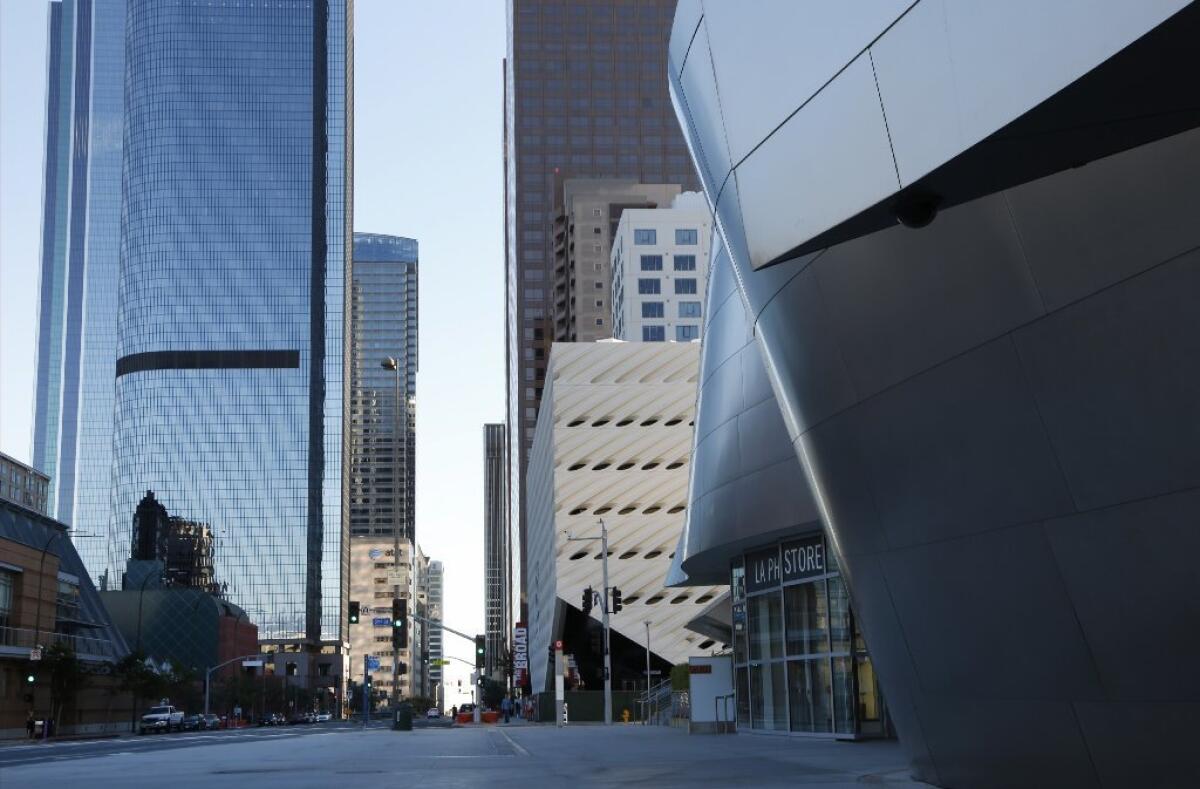
Rule No. 1: Walk.
Los Angeles may be a vast tangle of freeways best navigated on wheels, but there are plenty of walkable art hubs in the city, and the densest among them might be on Grand Avenue, between 1st and 4th streets. Here, clustered together, are the Broad museum, the Museum of Contemporary Art, Walt Disney Concert Hall and the Music Center’s Dorothy Chandler Pavilion, the latter of which houses some impressive but lesser-known fine art.
Since the Broad opened in 2015, this section of the so-called Grand Avenue culture corridor has blossomed — super-bloomed, if you will — regularly drawing unwieldy crowds of selfie-seeking millennials, expectant tourists and art-loving hipsters. A flurry of the requisite food carts serving vegan ice cream and watermelon-lime agua fresca followed, contributing to a lively scene that, on any given afternoon, is nearly as colorful as what’s inside the museums.
Here’s the rest of the rule book for how to maximize your art expedition. Wear shoes with good soles; there’s art traction to be had here.
FULL COVERAGE: Grand Avenue project »
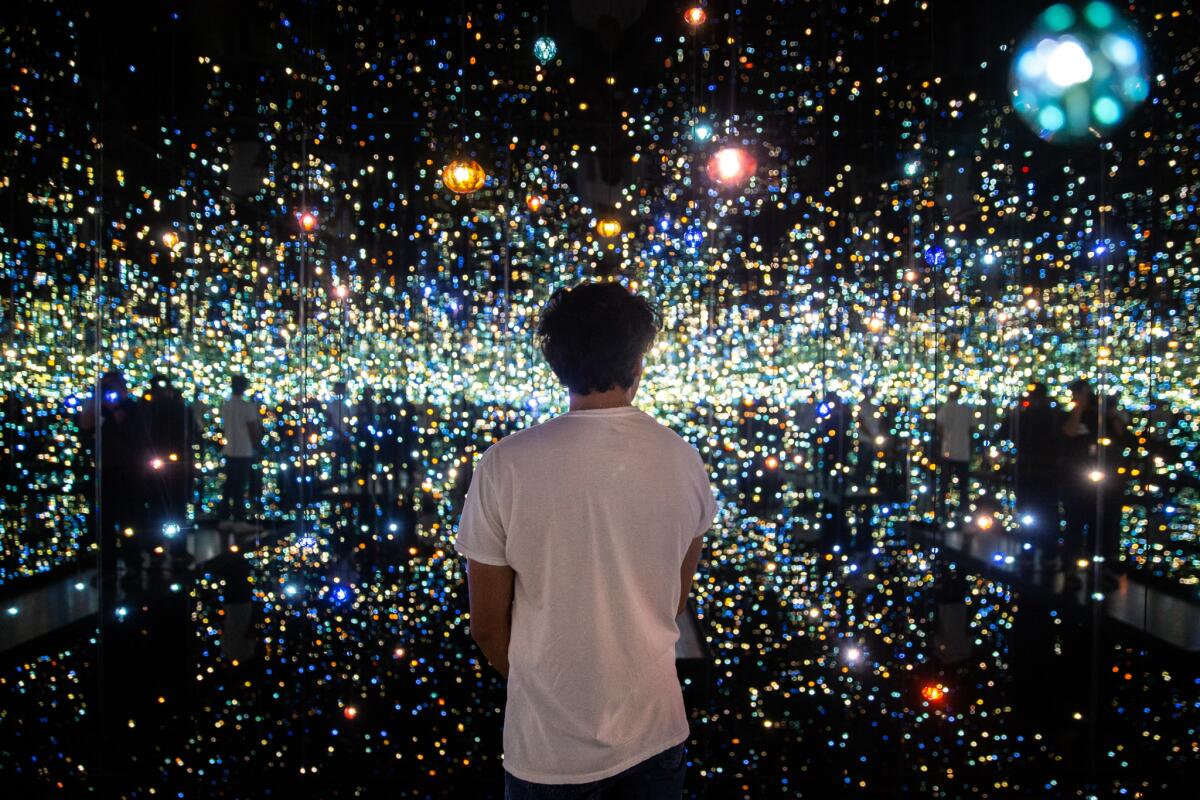
Rule No. 2: Say cheese — or watch others saying it.
What not to miss at the Broad: Since the museum’s debut, Eli and Edythe Broad’s vibrant collection of postwar and contemporary art, with its iconic Pop Art works by crowd-pleasers such as Andy Warhol, Roy Lichtenstein and Keith Haring, has been a social media magnet. Leading the pack as the museum’s most Instagrammed work is Yayoi Kusama’s immersive “Infinity Mirrored Room — The Souls of Millions of Light Years Away,” which draws roughly one visitor a minute. There are only a handful of Kusama’s infinity mirror rooms on view in the U.S., and this one — an intimate chamber tricked out with mirrors, twinkling LEDs and glistening water — is worth the added wait, a trippy and Zen-like experience at once.
Getting around the Broad is half the fun. The futuristic ride up the 105-foot-long lobby escalator deposits visitors into the belly of the building on the third floor (some have likened the escalator to a birth canal). Takashi Murakami’s psychedelic-looking mural, “In the Land of the Dead, Stepping on the Tail of a Rainbow,” and El Anatsui’s Kimona-like “Red Block,” made of flattened bottle caps and copper wire, are standouts of the collection and have long greeted visitors at the top of the escalator, in the central, third floor exhibition space. The works are currently on loan, but the space still houses must-see art, including Mark Bradford’s 34-foot work of social abstraction, “Helter Skelter I,” about cult leader Charles Manson’s ’60s-era obsession to start a race war and newly acquired pieces by Julie Mehretu, including her energetic if chaotic “Congress,” incorporating a vortex of swirling, national flag-like imagery.
If a super-sticky art selfie is your goal, Jeff Koons’ blingy “Tulips” sculpture is there too. And his shimmering, metallic “Balloon Dog (Blue),” along with Robert Therrien’s ginormous, Alice-in-Wonderland-like “Under the Table,” are in galleries on the same floor.
From there, make a beeline for one of the museum’s most beautiful if disturbing nooks, featuring the work of Kara Walker. A collection of her large-scale, silhouetted paper cutouts, “African’t,” spans a curved wall and explores the dark history of plantation life in the Deep South. Some of her most powerful works are tiny, delicate cutouts inside a case, “Burning African Village Play Set with Big House and Lynching,” presenting a frightening world, teeming with violence.
Don’t miss a peek into the museum’s transparent art storage area from the staircase landings, or the view from a third-floor corner gallery facing north — the building’s milky, honeycomb-like architecture offers glimpses of Disney Hall’s gleaming, silvery curves across the street and patches of street life below.
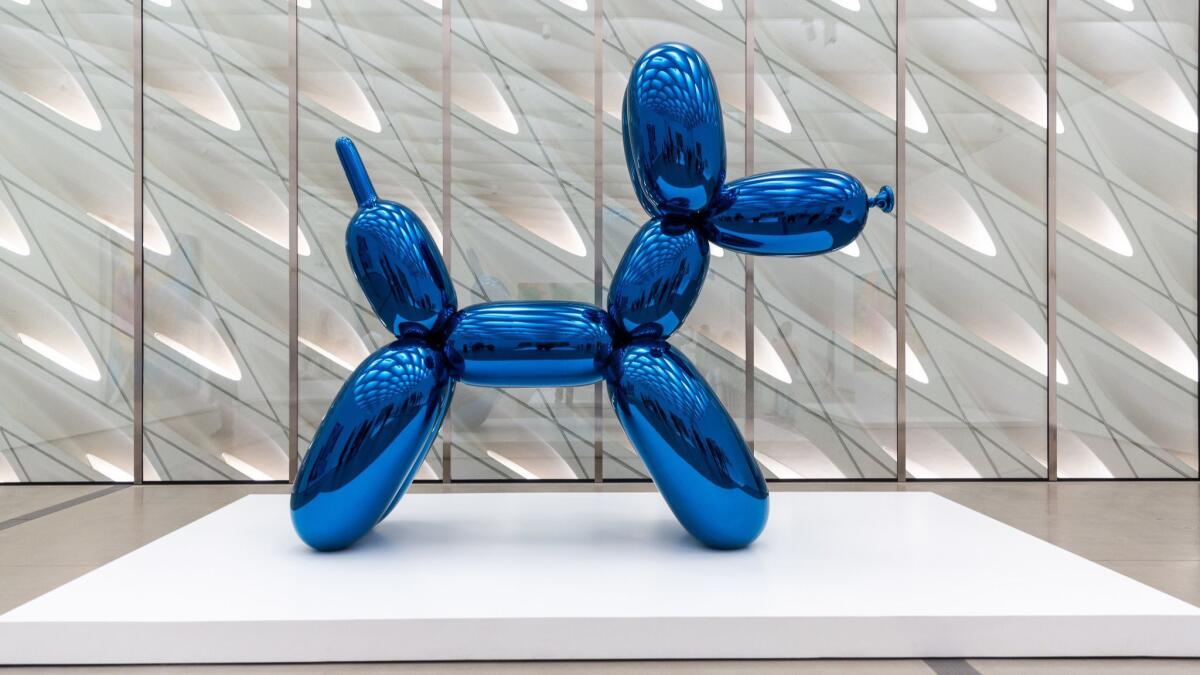
Rule No. 3: Channel your inner artist.
What not to miss at MOCA: If the Broad is one man’s collection, or vision, then MOCA, across the street, is a collection of collections. The contemporary art museum, with its more than 7,000 works from the 1940s on, is often called the artists’ museum, as it was founded by local artists and civic leaders in 1979.
The museum features one of the largest collections of Mark Rothko works in the country. Visitors travel from all over the globe to see the “Rothko room,” with about half a dozen towering canvases, at any one time, in delicious, saturate hues of red, yellow, orange and purple.
Among the many collections gifted to the museum by artists and patrons is the Panza Collection, 80 abstract expressionist and Pop Art works from Italian collector Count Giuseppe Panza di Biumo, which includes works by Franz Kline, Roy Lichtenstein, Robert Rauschenberg and James Rosenquist. More recently, the Blake Byrne Collection, acquired in 2004, features works by 78 artists such as Gordon Matta-Clark, Felix Gonzalez-Torres and Mike Kelley, among others. All of which amounts to a prism of perspectives channeled through art.
MOCA’s iconic, action-oriented Jackson Pollock painting, “Number 1, 1949” — which the artist created by hurling paint straight from the can onto the canvas or dripping it from sticks — is being restored but will be back on view this summer. And other pillars of the collection remain on view. Among them: Alberto Giacometti’s tall, spindly bronze sculptures, “Tall Figure II” and “Tall Figure III,” which echo both the horrors of World War II and the contemporary global refugee crisis; and a wall of Claes Oldenburg’s painted plaster objects — clothing, food and household items one might find in a neighborhood store — that collectively speak to materialism, consumer culture and the commercialization of art.
The Arata Isozaki-designed MOCA building itself is of note, considered an important example of postmodern architecture, with an emphasis on geometric forms — pyramids and squares and circles. And just a few blocks away, it’s worth noting, is the museum’s vast 40,000-square-foot Geffen Contemporary space. Barbara Kruger’s 1990 mural on the building’s exterior, “Untitled (Questions),” was recently re-installed there and urgently asks passersby: “Who is beyond the law?” “Who dies first?” and “Who laughs last?”
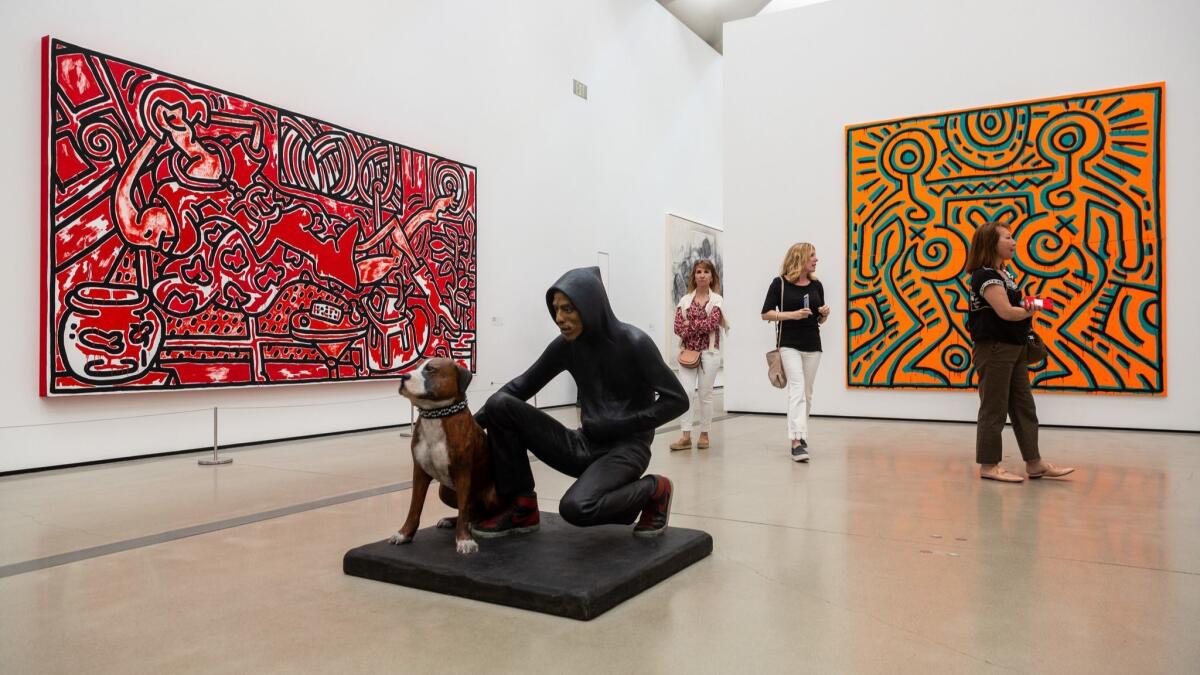
Rule No. 4: Follow the cat in the purple smoking jacket.
What not to miss at the Walt Disney Concert Hall: Sure, the building itself might be Los Angeles’ most recognizable, not to mention one of the crowning achievements of architect Frank Gehry’s career. But once you’ve snapped a picture of the exterior of Disney Hall and visited its famous, French fry-like pipe organ, wind your way back down to the lobby and sign up for “Thought Experiments in F# Minor.” If you dare.
The mind-bending work, from Canadian artist duo Janet Cardiff and George Bures Miller, is a free, immersive, augmented reality “video walk,” with 3-D sound, through Disney Hall and its environs. It was one of several commissions marking the Los Angeles Philharmonic’s centennial season. As they navigate the building, guests don puffy headphones and watch a pre-recorded video, on a Disney Hall-provided iPad Mini, hosted by a mischievous hairless cat in said smoking jacket.
The work is dense and poetic, weaving poetry, quantum physics, science fiction and news events — not to mention musical performances by the Los Angeles Philharmonic — all while employing multimedia to distort participants’ sense of reality.
On the way out, don’t miss the massive 48-foot-long mural, “Blue,” by California light and space artist Peter Alexander. Gehry requested he make the work for the building. It hangs along a terrace-level staircase, depicting sunlight flickering on the Pacific Ocean’s surface.
REDCAT, CalArts’ downtown center for contemporary arts on the lower level of Disney Hall, includes a 3,000-square-foot gallery worth swinging by that features rotating exhibitions of experimental work by international artists as well as a black-box theater and bar.
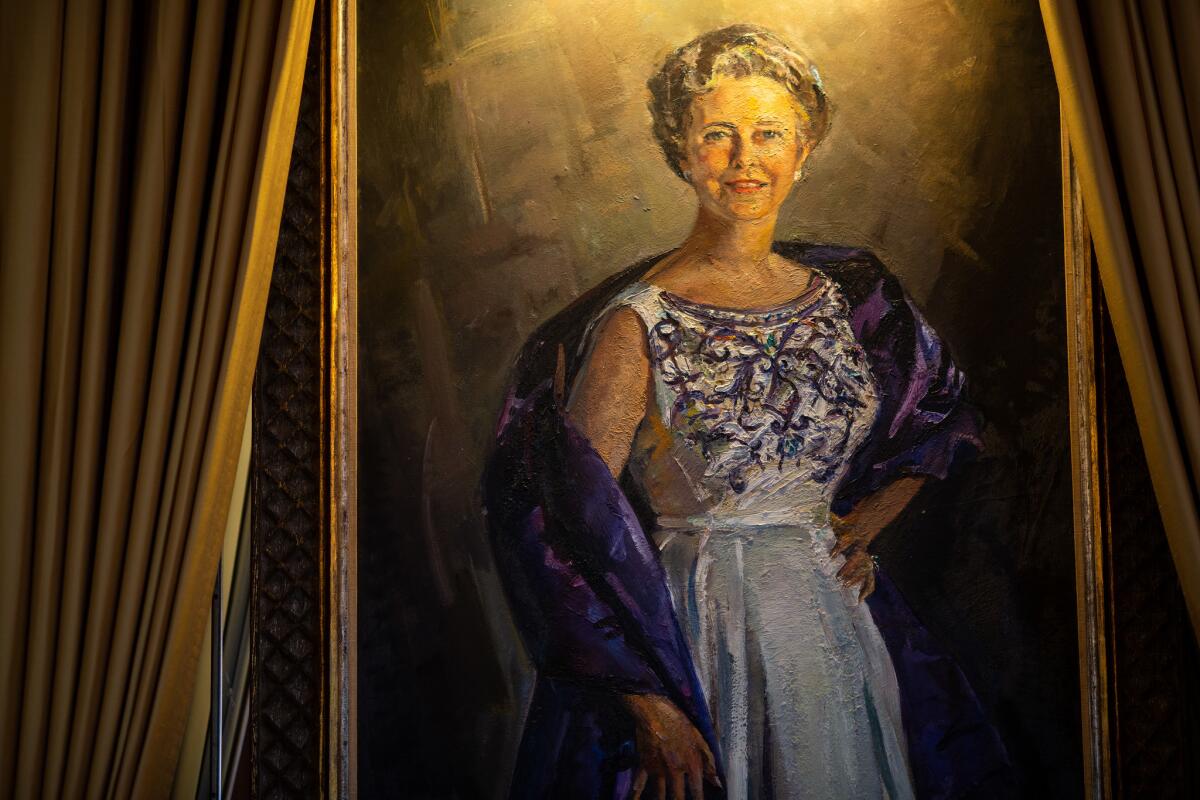
Rule No. 5: Pay your respects.
What not to miss at the Dorothy Chandler Pavilion: In the mid-1950s, Dorothy Buffum Chandler, wife of Los Angeles Times publisher Norman Chandler, willed the Music Center’s first building into existence by leading a campaign that raised nearly $19 million in private donations. Today, honoring her efforts, there’s an imposing portrait of “Buffy” by William F. Draper in the Dorothy Chandler Pavilion’s Founders Room that looms over VIP guests sipping champagne during intermission at the opera. The building’s midcentury glam exterior and grandiose interior, with its draping crystal chandeliers, gets all the attention; but there’s actually notable fine art throughout — and free art tours through the Music Center.
The Founders Room features works on loan, indefinitely, from the Los Angeles County Museum of Art. The exhibit includes eight artworks by under-recognized female artists working in Southern California in the ’30s and ’40s. Claire Falkenstein’s abstract metal sculpture, “Vibration,” as well as her painting “Tapping Out Steel”; June Harwood’s simplistic geometric “Sliver Series (Blue, Violet, Green)”; and Gloria Stuart’s “Watts Towers I” are standouts.
Elsewhere in the building, hovering over the antique marble bar on the second floor, is Thomas Hardy’s ceiling-mounted, gold-leafed bronze sculpture, “Sun Birds.” The clusters of what amount to 500 birds glimmer against the room’s dark mirrors and black walnut paneling, giving them an almost animated, dramatic effect.
Other notable artworks surround the bar, including Frank Stella’s bold, minimalist painting “Ossipee III”; a “Signature Quilt,” a work created by artist Sandi Fox in 1981 that features embroidered signatures of Music Center supporters and performing artists such as Yo-Yo Ma, Gregory Peck and Natalie Wood; and a tapestry by Mexican artist Leonardo Nierman that captures, the artist once said, “the eternal romance between music and color.”
Rule No. 6: Rest. You’ll need it.
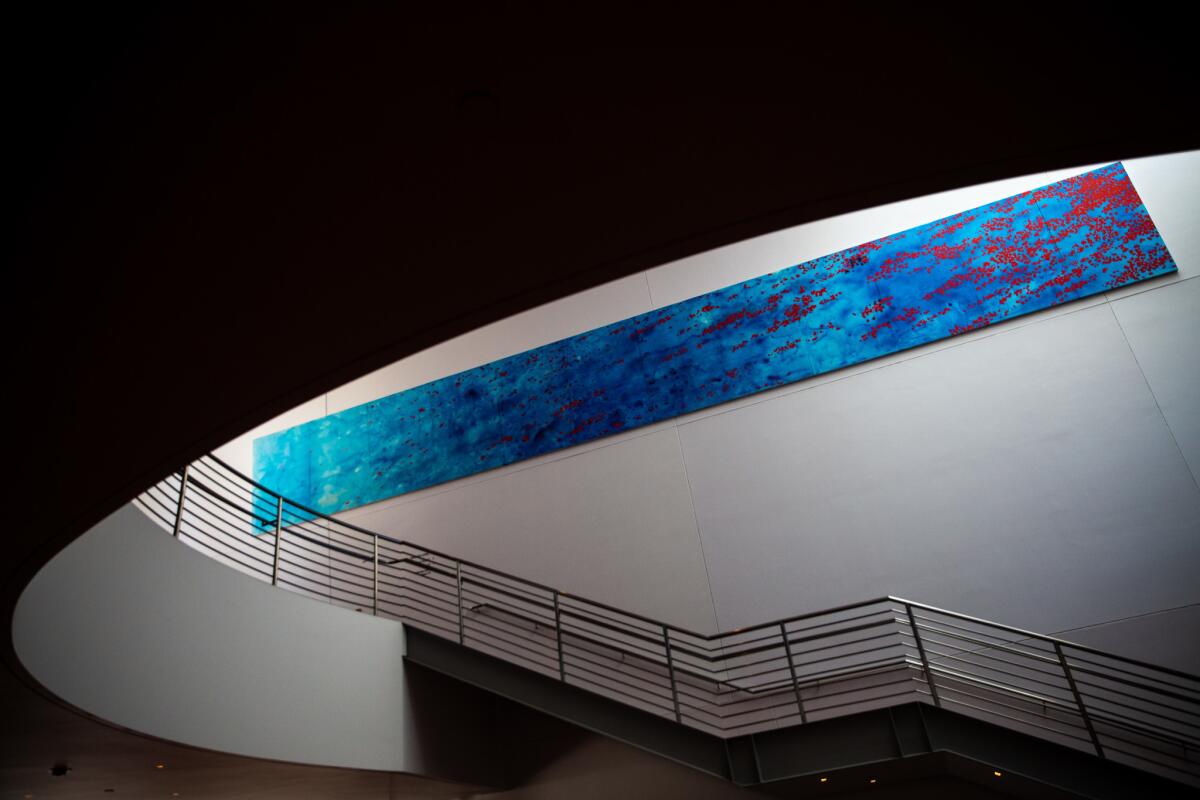
More to Read
The biggest entertainment stories
Get our big stories about Hollywood, film, television, music, arts, culture and more right in your inbox as soon as they publish.
You may occasionally receive promotional content from the Los Angeles Times.











